Related Research Articles
Tibetan may mean:

For more than a thousand years, Tibetan artists have played a key role in the cultural life of Tibet. From designs for painted furniture to elaborate murals in religious buildings, their efforts have permeated virtually every facet of life on the Tibetan plateau. The vast majority of surviving artworks created before the mid-20th century are dedicated to the depiction of religious subjects, with the main forms being thangka, distemper paintings on cloth, Tibetan Buddhist wall paintings, and small statues in bronze, or large ones in clay, stucco or wood. They were commissioned by religious establishments or by pious individuals for use within the practice of Tibetan Buddhism and were manufactured in large workshops by monks and lay artists, who are mostly unknown.

David Tibet is a British poet and artist who founded the music group Current 93, of which he is the only full-time member.

A thangka, variously spelt as thangka, tangka, thanka, or tanka, is a Tibetan Buddhist painting on cotton, silk appliqué, usually depicting a Buddhist deity, scene, or mandala. Thangkas are traditionally kept unframed and rolled up when not on display, mounted on a textile backing somewhat in the style of Chinese scroll paintings, with a further silk cover on the front. So treated, thangkas can last a long time, but because of their delicate nature, they have to be kept in dry places where moisture will not affect the quality of the silk. Most thangkas are relatively small, comparable in size to a Western half-length portrait, but some are extremely large, several metres in each dimension; these were designed to be displayed, typically for very brief periods on a monastery wall, as part of religious festivals. Most thangkas were intended for personal meditation or instruction of monastic students. They often have elaborate compositions including many very small figures. A central deity is often surrounded by other identified figures in a symmetrical composition. Narrative scenes are less common, but do appear.

Tibet House is an international, loosely affiliated group of nonprofit, cultural preservation organizations founded at the request of the Dalai Lama to preserve, present and protect Tibet's ancient traditions of philosophy, mind science, art, and culture due to the Chinese invasion of Tibet and subsequent Tibetan diaspora. The first Tibet House was founded in New Delhi, India in 1965.

The following outline is provided as an overview of and topical guide to Tibet:
Philip Sugden studied art in Paris under French painter, Arnaud D'Hauterives. After graduating from the New York School of Visual Arts and the Paris American Academie des Beaux Arts in Paris, he made twelve journeys throughout the Himalaya and Tibet, including the Kingdom of Mustang and Ladakh. In May 2007, he and writer, Carole Elchert were married by Lama Nawang Tenzin at Tengboche Monastery near Mt. Everest.
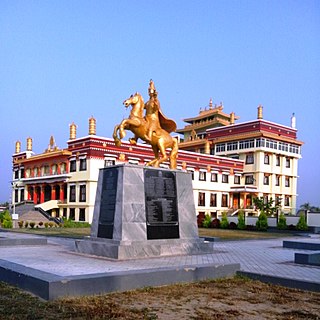
The Tibetan diaspora are the diaspora of Tibetan people living outside China.
Tibetan literature generally refers to literature written in the Tibetan language or arising out of Tibetan culture. Historically, Tibetan has served as a trans-regional literary language that has been used, at different times, from Tibet to Mongolia, Russia, and present-day Bhutan, Nepal, India, and Pakistan. Today, the term Tibetan literature can also be applied to any work by an ethnic Tibetan person or arising out of Tibetan folk culture; contemporary Tibetan writers sometimes use Chinese, English, or other languages to compose their work.

Lina Dorado is a contemporary artist and filmmaker based in New York City noted for her multimedia work and travel photography, Lina Dorado has authored two books in bilingual editions: Doble Vista / Second Sight and Drawing Only, Solo Dibujo alongside her long term collaborator: Luis Cantillo. Their book Doble Vista / Second Sight written by Dorado and photographs by both was acquired by the New York Public Library Museum of Modern Art in New York MOMA and the Whitney Museum for their Artists' Books Collection. On August 2018 her first feature film Pelucas y Rokanrol was theatrically released in Colombia, the film was directed by Mario Duarte and written by Mario Duarte and Lina Dorado ..
Steve Lehman is an American-born conceptual artist whose oeuvre consists of photographs, videos, collages, drawings, writings, sculpture, objects, paintings and installations. He is also the founder of WillyNilly™, a digital lifestyle company. He is most famous for his book The Tibetans: A Struggle to Survive. Lehman’s work is distinct because of his ability to “sample” other artists, weave together many types of art and merge different disciplines.
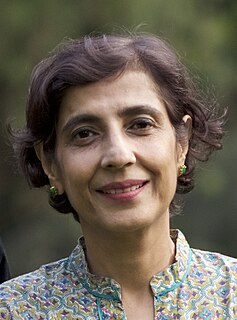
Ritu Sarin is an Indian film director, producer and artist based in Dharamshala, India. She was born in New Delhi. She did her undergraduate studies at Miranda House in Delhi University and went on to do her MFA in Film and Video from California College of the Arts in Oakland. She is the recipient of Miranda House’s 2010 Distinguished Alumna Award. She is married to Tibetan filmmaker Tenzing Sonam with whom she has two children.

Tenzing Sonam is a Tibetan film director, writer and essayist. He works through his production company, White Crane Films, which he runs with his partner, Ritu Sarin.
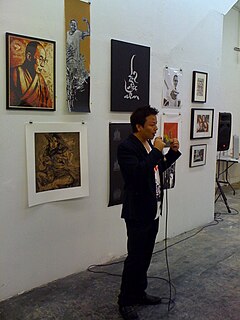
Tenzing Rigdol is a contemporary Tibetan artist and activist.

Bringing Tibet Home is a 2013 documentary film produced and directed by Tibetan filmmaker Tenzin Tsetan Choklay about Tibetan contemporary Artist Tenzing Rigdol's art piece "Our Land Our people". The film premiered at the 2013 Busan International Film Festival in South Korea. This is a Tibetan-language film.
Chen Danqing is a Chinese-American artist, writer, and art critic. He is well known for his realist paintings of Tibetans. Chen graduated from China Central Academy of Fine Arts. Because his grandfather moved to Taiwan with the Nationalist government, he also had citizenship in the Republic of China. He moved to the United States in the 1982 and became a citizen there.
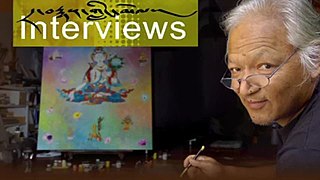
Karma Phuntsok is a Tibetan painter.
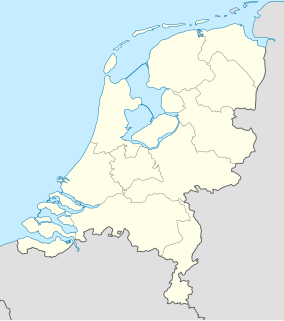
The Museum of Contemporary Tibetan Art is a museum in the Rensenpark in Emmen, at the northeast of the Netherlands near Germany. It displays permanent and temporary exhibitions of contemporary Tibetan art.

Tibet House US (THUS) is a Tibetan cultural preservation and education nonprofit founded in 1987 in New York City by a group of Westerners after the Fourteenth Dalai Lama, Tenzin Gyatso, had expressed his wish to establish a cultural institution to build awareness of Tibetan culture.